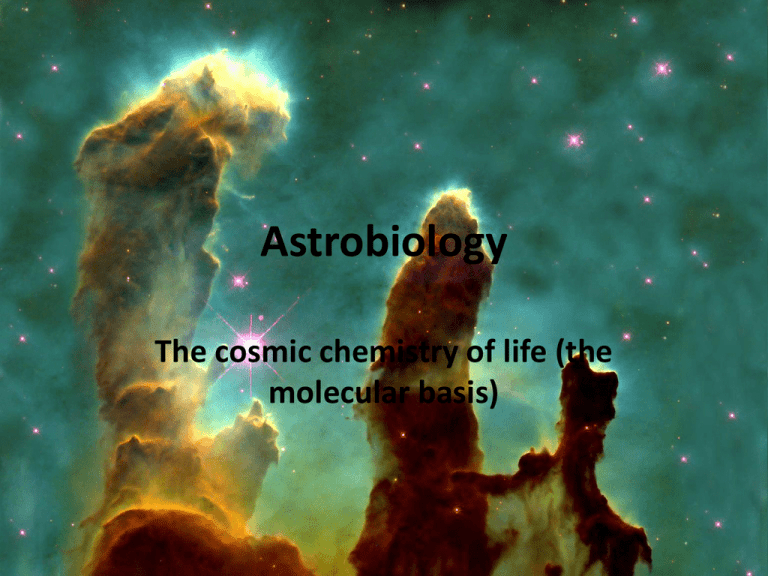Chemistry to Biology
advertisement

Astrobiology The cosmic chemistry of life (the molecular basis) Chemistry to Biology • The history of the cosmos has been one of increasing complexity (from astrochemistry to astrobiology). – Chemical – nucleosynthesis and the formation of more complex molecules. • This is the cosmic soup (formally called the Interstellar Medium). – Biological - evolving molecules capable of autocatalysis giving rise to “living” organisms. Setting the Stage • Going back to the 1960s, it was believed that space was a void. – That there was no chemistry, no nothing, whatsoever in the space between stars, planets, and other bodies. – Temperatures were thought to be too low and radiation too high – any chemical molecule (like water, methane, ammonia, etc.) would be ripped apart. Setting the Stage • In 1969, astronomers made the momentous discovery of molecules of ammonia and formaldehyde in space. • That discovery was followed up by the discovery of carbon monoxide in 1970. Setting the Stage • These were, at the time, momentous discoveries (what was happening at this time?) The Beginning of Astrochemistry • The discovery of those molecules showed us that chemistry was possible in the “interstellar medium.” • So we asked the question: “Could there exist, out there, molecules that have function?” – What might those functions be? The Periodic Table as We Know It An Astrochemist’s Periodic Table Size of the element’s symbol is proportional to how much of each element is out there. The Elements of Life • Thinking about that periodic table, what do those elements have to do with life? – All life on Earth is made predominately of carbon, oxygen, nitrogen, and hydrogen. – Interestingly enough, even though Earth is a silicate rock, silicon does not figure into our biology. The Chemistry Was in Plain Sight (Sort of) • Our sight is restricted to only the visible spectrum – there is a lot out there we couldn’t see (and did not realize it). • When we started to use other instruments like infrared light detectors and mass spectroscopy, we began to see space for what it is – anything but a void. – There is a lot more happening than we realized – like giant molecular clouds. The Chemistry Was in Plain Sight (Sort of) After our discovery of chemistry, we began to look for it in our system and other systems. Infrared was the key. Studying the Cosmic Soup Studying the Cosmic Soup • Once we started to look at the universe with the right set of tools, we began to see all sorts of surprising things. • We discovered lots of organic compounds and ices. – We learned that water is an extremely common compound. Studying the Cosmic Soup An example of what we discovered comes from this comparison of a spectrum taken from the Orion Nebula and one taken from diesel fumes. Studying the Cosmic Soup • We have discovered that the powerful UV-rays found in space (the same ones that give you skin cancer) drive all sorts of chemical reactions. • The “skin” of every interstellar cloud we see is made up of what we call PAHs (Polycyclic Aromatic Hydrocarbons). – In other words, they are loaded with organic compounds. Studying the Cosmic Soup The red coloration is indicative of organic compounds Studying the Cosmic Soup What Do We Know (Summary) • We know there is a lot of freely accessible carbon in forming solar systems (and, therefore, presumably there was in ours). • We know hydrocarbons are found in meteorites, comets, and interplanetary dust particles. • We know the amount of available carbon has been around for a long time (within 2 billion years of the Big Bang). The Scope of Molecular Complexity Ex. Carbon Monoxide and UV All of these molecules are found in the interstellar medium Interstellar Ices • We find all of the organic molecules we have been talking about in ices. – There are ices that contain compounds made from hydrogen, oxygen, nitrogen, helium, carbon – silicon serves as a core or nucleus. – Ice forms in space the same way it forms here on Earth – beginning with a speck of dust as a core. – Water is the number one molecule found in ices. Ices Ices form in space just as snow flakes form here on Earth Occurrence of Ices Questions • Why were the interstellar ices so important to the formation of the solar systems? • Why were they so important to the formation of Earth?











